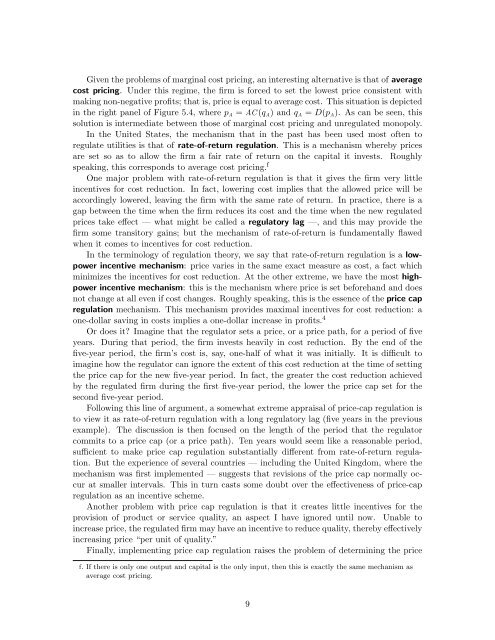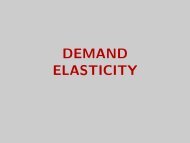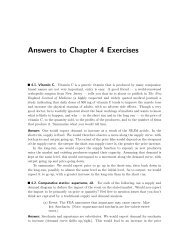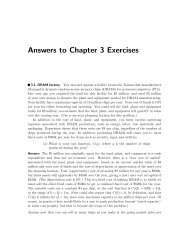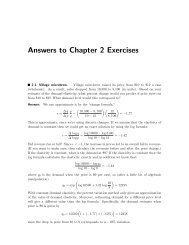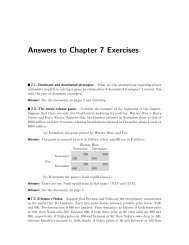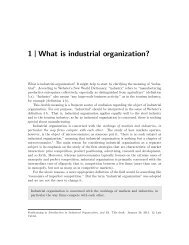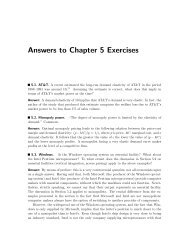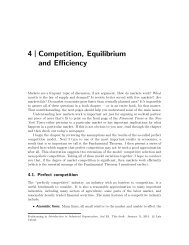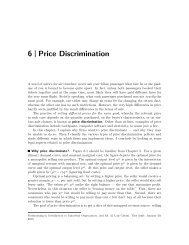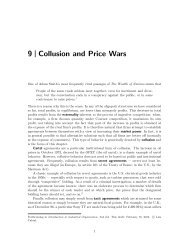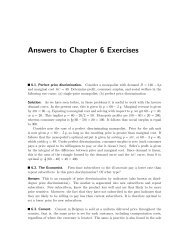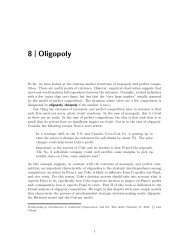5 Monopoly and Regulation - Luiscabral.net
5 Monopoly and Regulation - Luiscabral.net
5 Monopoly and Regulation - Luiscabral.net
Create successful ePaper yourself
Turn your PDF publications into a flip-book with our unique Google optimized e-Paper software.
Given the problems of marginal cost pricing, an interesting alternative is that of averagecost pricing. Under this regime, the firm is forced to set the lowest price consistent withmaking non-negative profits; that is, price is equal to average cost. This situation is depictedin the right panel of Figure 5.4, where p A = AC (q A ) <strong>and</strong> q A = D(p A ). As can be seen, thissolution is intermediate between those of marginal cost pricing <strong>and</strong> unregulated monopoly.In the United States, the mechanism that in the past has been used most often toregulate utilities is that of rate-of-return regulation. This is a mechanism whereby pricesare set so as to allow the firm a fair rate of return on the capital it invests. Roughlyspeaking, this corresponds to average cost pricing. fOne major problem with rate-of-return regulation is that it gives the firm very littleincentives for cost reduction. In fact, lowering cost implies that the allowed price will beaccordingly lowered, leaving the firm with the same rate of return. In practice, there is agap between the time when the firm reduces its cost <strong>and</strong> the time when the new regulatedprices take effect — what might be called a regulatory lag —, <strong>and</strong> this may provide thefirm some transitory gains; but the mechanism of rate-of-return is fundamentally flawedwhen it comes to incentives for cost reduction.In the terminology of regulation theory, we say that rate-of-return regulation is a lowpowerincentive mechanism: price varies in the same exact measure as cost, a fact whichminimizes the incentives for cost reduction. At the other extreme, we have the most highpowerincentive mechanism: this is the mechanism where price is set beforeh<strong>and</strong> <strong>and</strong> doesnot change at all even if cost changes. Roughly speaking, this is the essence of the price capregulation mechanism. This mechanism provides maximal incentives for cost reduction: aone-dollar saving in costs implies a one-dollar increase in profits. 4Or does it? Imagine that the regulator sets a price, or a price path, for a period of fiveyears. During that period, the firm invests heavily in cost reduction. By the end of thefive-year period, the firm’s cost is, say, one-half of what it was initially. It is difficult toimagine how the regulator can ignore the extent of this cost reduction at the time of settingthe price cap for the new five-year period. In fact, the greater the cost reduction achievedby the regulated firm during the first five-year period, the lower the price cap set for thesecond five-year period.Following this line of argument, a somewhat extreme appraisal of price-cap regulation isto view it as rate-of-return regulation with a long regulatory lag (five years in the previousexample). The discussion is then focused on the length of the period that the regulatorcommits to a price cap (or a price path). Ten years would seem like a reasonable period,sufficient to make price cap regulation substantially different from rate-of-return regulation.But the experience of several countries — including the United Kingdom, where themechanism was first implemented — suggests that revisions of the price cap normally occurat smaller intervals. This in turn casts some doubt over the effectiveness of price-capregulation as an incentive scheme.Another problem with price cap regulation is that it creates little incentives for theprovision of product or service quality, an aspect I have ignored until now. Unable toincrease price, the regulated firm may have an incentive to reduce quality, thereby effectivelyincreasing price “per unit of quality.”Finally, implementing price cap regulation raises the problem of determining the pricef. If there is only one output <strong>and</strong> capital is the only input, then this is exactly the same mechanism asaverage cost pricing.9


